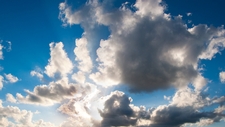Clouds

TEKS Objective
The student is expected to observe and record changes in the appearance of objects in the sky such as clouds, the Moon, and stars, including the Sun.
Essential Understanding
The student knows that the natural world includes the air around us and objects in the sky.
Science Background
What are Clouds? NASA (website) - Learn about cloud composition, different types of clouds, and why clouds are important.
What are Clouds?
NASA, www.nasa.gov
Clouds: Exploring Weather (website) - Information about cloud formation, properties, and movement, and about different cloud forms.
Signature Lesson
Clouds, A Teaching Box: UCAR Center for Science Education (website) - Students learn how to observe and describe clouds.
Cloud, A Teaching Box
UCAR, Center for Science Education www.scied.ucar.edu
- Supporting Lessons
- Extensions
- Assessment Ideas
- Literature Connections
- Related
TEKS - Additional Resources
Supporting Lessons
Do You Know That Clouds Have Names? The Globe Program (website) - Join Simon, Anita and Dennis as they explore cloud names. This module includes a storybook and accompanying learning activities.
Do You Know That Clouds Have Names?
The Globe Program, www.globe.gov
Make a Cloud Mobile: NASA (website) - Make a “cloud mobile” with common household materials to reinforce understanding of different types of clouds.
Make a Cloud Mobile
NASA, The Space Place, spaceplace.nasa.gov
Elaboration Lessons and Extensions
Create a Cloud in a Bottle: NASA, S’Cool (website) - Identify and create the conditions necessary for clouds to form. Includes assessment.
Create a Cloud in a Bottle
NASA Student Cloud Observations Online, scool.larc.nasa.gov
Make Fog in a Jar: University Corporation for Atmospheric Research (website) - Fog is a cloud that touches the ground or the surface of a body of water. In this investigation, students create and observe fog in a jar.
Make Fog in a Jar
University Corporation for Atmospheric Research, eo.ucar.edu
Assessment Ideas
Have each student make a Cloud Journal in his/her science notebook, and draw and describe the appearance of clouds in the sky each day for two weeks.
Literature Connections
Let’s Read-and-Find-Out Science Series: Clouds. Rockwell, Anne (ISBN: 0064452204)
Ready to Read: Clouds. Bauer, Marion Dane (ISBN: 0756956161)
Additional Resources
Science Activities: University Corporation for Atmospheric Research (website) - Hands-on lessons that help to demonstrate the forces and conditions that produce clouds and other weather events.
Science Activities
University Corporation for Atmospheric Research, eo.ucar.edu
TEKS Navigation
Grade 1
Need Assistance?
If you need help or have a question please use the links below to help resolve your problem.

Comments